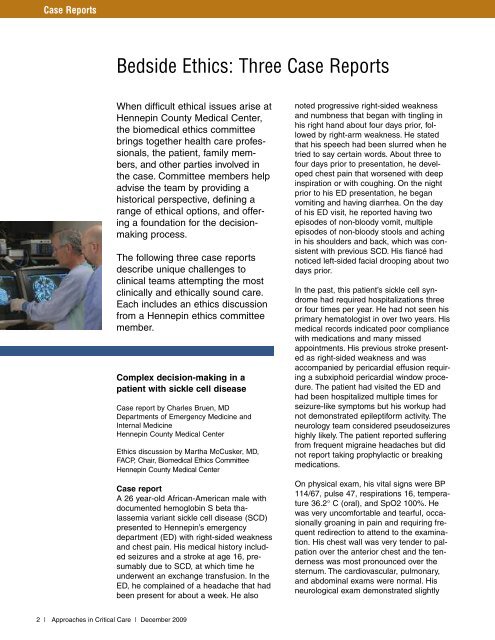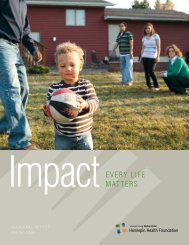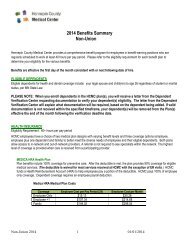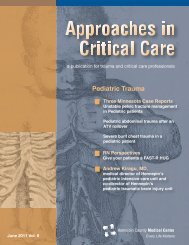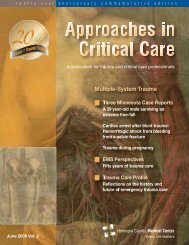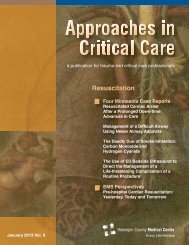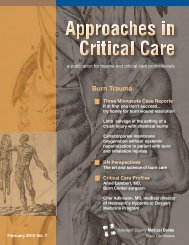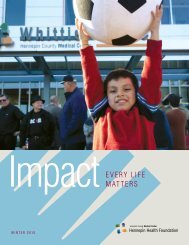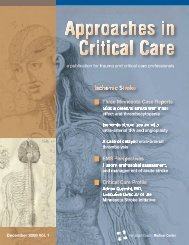Download - Hennepin County Medical Center
Download - Hennepin County Medical Center
Download - Hennepin County Medical Center
You also want an ePaper? Increase the reach of your titles
YUMPU automatically turns print PDFs into web optimized ePapers that Google loves.
Case Reports<br />
Bedside Ethics: Three Case Reports<br />
When difficult ethical issues arise at<br />
<strong>Hennepin</strong> <strong>County</strong> <strong>Medical</strong> <strong>Center</strong>,<br />
the biomedical ethics committee<br />
brings together health care professionals,<br />
the patient, family members,<br />
and other parties involved in<br />
the case. Committee members help<br />
advise the team by providing a<br />
historical perspective, defining a<br />
range of ethical options, and offering<br />
a foundation for the decisionmaking<br />
process.<br />
The following three case reports<br />
describe unique challenges to<br />
clinical teams attempting the most<br />
clinically and ethically sound care.<br />
Each includes an ethics discussion<br />
from a <strong>Hennepin</strong> ethics committee<br />
member.<br />
Complex decision-making in a<br />
patient with sickle cell disease<br />
Case report by Charles Bruen, MD<br />
Departments of Emergency Medicine and<br />
Internal Medicine<br />
<strong>Hennepin</strong> <strong>County</strong> <strong>Medical</strong> <strong>Center</strong><br />
Ethics discussion by Martha McCusker, MD,<br />
FACP, Chair, Biomedical Ethics Committee<br />
<strong>Hennepin</strong> <strong>County</strong> <strong>Medical</strong> <strong>Center</strong><br />
Case report<br />
A 26 year-old African-American male with<br />
documented hemoglobin S beta thalassemia<br />
variant sickle cell disease (SCD)<br />
presented to <strong>Hennepin</strong>’s emergency<br />
department (ED) with right-sided weakness<br />
and chest pain. His medical history included<br />
seizures and a stroke at age 16, presumably<br />
due to SCD, at which time he<br />
underwent an exchange transfusion. In the<br />
ED, he complained of a headache that had<br />
been present for about a week. He also<br />
noted progressive right-sided weakness<br />
and numbness that began with tingling in<br />
his right hand about four days prior, followed<br />
by right-arm weakness. He stated<br />
that his speech had been slurred when he<br />
tried to say certain words. About three to<br />
four days prior to presentation, he developed<br />
chest pain that worsened with deep<br />
inspiration or with coughing. On the night<br />
prior to his ED presentation, he began<br />
vomiting and having diarrhea. On the day<br />
of his ED visit, he reported having two<br />
episodes of non-bloody vomit, multiple<br />
episodes of non-bloody stools and aching<br />
in his shoulders and back, which was consistent<br />
with previous SCD. His fiancé had<br />
noticed left-sided facial drooping about two<br />
days prior.<br />
In the past, this patient’s sickle cell syndrome<br />
had required hospitalizations three<br />
or four times per year. He had not seen his<br />
primary hematologist in over two years. His<br />
medical records indicated poor compliance<br />
with medications and many missed<br />
appointments. His previous stroke presented<br />
as right-sided weakness and was<br />
accompanied by pericardial effusion requiring<br />
a subxiphoid pericardial window procedure.<br />
The patient had visited the ED and<br />
had been hospitalized multiple times for<br />
seizure-like symptoms but his workup had<br />
not demonstrated epileptiform activity. The<br />
neurology team considered pseudoseizures<br />
highly likely. The patient reported suffering<br />
from frequent migraine headaches but did<br />
not report taking prophylactic or breaking<br />
medications.<br />
On physical exam, his vital signs were BP<br />
114/67, pulse 47, respirations 16, temperature<br />
36.2° C (oral), and SpO2 100%. He<br />
was very uncomfortable and tearful, occasionally<br />
groaning in pain and requiring frequent<br />
redirection to attend to the examination.<br />
His chest wall was very tender to palpation<br />
over the anterior chest and the tenderness<br />
was most pronounced over the<br />
sternum. The cardiovascular, pulmonary,<br />
and abdominal exams were normal. His<br />
neurological exam demonstrated slightly<br />
2 | Approaches in Critical Care | December 2009


